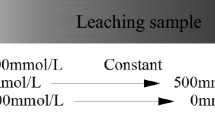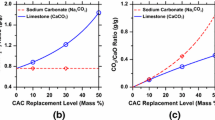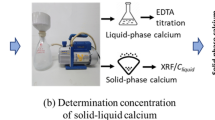Abstract
The reaction of Ca(PO4)2O (TTCP) and CaHPO4 (DCPA) in an aqueous solution has been shown to be responsible for the hardening of a calcium phosphate cement. This reaction was investigated by monitoring pH changes and composition of solid phases. In the first set of experiments (no attempt to control pH), 2.5 g each of mixtures of TTCP/DCPA, molar ratio from 0.25 to 2, was placed in 12.5 mL of 0.15 mol/L KCl solution, at initial pH about 7, and the pH was allowed to drift for 24 h. Results show that at any time up to 24 h, the pHs were higher for slurries with higher TTCP/DCPA molar ratios. For the slurries with TTCP/DCPA molar ratio of ≥ 0.83, the 24 h pHs of the slurries were 9 to 11, whereas for those with TTCP/DCPA of ≤ 0.67, the pHs were between 5.3 and 7. The slurries with TTCP/DCPA molar ratios between 0.5 and 1 (Ca/P molar ratio=1.5 to 1.67) reacted completely within 24 h to form hydroxyapatite(OHAp), Ca5(PO4)3OH. In the second set of experiments, 2 g of an equimolar TTCP and DCPA mixture was placed in 20 mL of 0.15 mol/L KCl solution. The pH values were kept constant (6, 8 or 10) by using H3PO4 and Ca(OH)2 or HCl and KOH as titrant solutions. At pH 8, DCPA and TTCP dissolved at about the same rate, whereas at pH 10, DCPA was consumed more rapidly than TTCP. At both pHs, OHAp was the only product formed. However, at pH 6, the composition of reaction products depended on the types of the titrants used. Specifically when H3PO4 and Ca(OH)2 were used, hydrolysis of TTCP was the predominant reaction and both octacalcium phosphate and OHAp were formed. But, when HCl and KOH were used, only OHAp was formed. In this case hydrolysis of TTCP and DCPA appeared to proceed independently with TTCP hydrolysis beginning immediately and progressing slowly through 48 h while the DCPA hydrolysis began several hours after the reaction started but was completed in 24 h. ©2000 Kluwer Academic Publishers
Similar content being viewed by others
References
W. E. BROWN and L. C. CHOW, in “Cements research progress”, edited by P. W. Brown (Am. Ceram. Soc., Westerville, Ohio, 1986) p. 352.
L. C. CHOW, S. TAKAGI, A. SUGAWARA, E. D. EANES and B. HEYWOOD, J. Dent. Res. 66 (1987) 190, Abstract No. 672.
Y. FUKASE, E. D. EANES, S. TAKAGI, L. C. CHOW and W. E. BROWN, ibid. 69 (1990) 1852.
Y. DOI, S. SHIBATA, Y. TAKEZAWA, N. WAKAMATSU, H. KAMEMIZU, M. IIJIMA, Y. MORIWAKI, K. UNO, F. KUBO and Y. HAEUCHI, J. Jpn. Soc. Dental Mater. Dev. 6 (1987) 53.
C. LIU, W. SHEN, Y. GU and L. HU, J. Biomed. Mater. Res. 35 (1997) 75.
P. W. BROWN and M. FULMER, J. Am. Ceram. Soc. 74 (1991) 934.
P. W. BROWN, N. HOCKER and S. HAYLE, ibid. 74 (1991) 1848.
M. FULMER and P. W. BROWN, J. Biomed. Mater. Res. 27 (1993) 1095.
P. W. BROWN and M. FULMER, ibid. 31 (1996) 395.
K. S. TENHUSIEN and P. W. BROWN, J. Mater. Sci.: Mater. Med. 7 (1996) 309.
Y. DOI, S. SHIBATA, Y. TAKEZAWA, N. WAKAMATSU, H. KAMEMIZU, M. IIJIMA, Y. MORIWAKI, K. UNO, F. KUBO and Y. HAEUCHI, J. Jpn. Soc. Dental Mater. Dev. 7 (1988) 176.
L. XIE and E. A. MONROE, Mater. Res. Symp. Proc. 179 (1991) 25.
H. MONMA, M. GOTO, H. NAKAJIMA and H. HASHIMOTO, Gypsum & Lime 202 (1986) 17.
S. R. RADIN and P. DUCHEYNE, J. Biomed. Mater. Res. 27 (1993) 35.
S. MATSUYA, S. TAKAGI and L. C. CHOW, J. Mater. Sci. 31 (1996) 3263.
R. STRUSBURG, B. LINK, S. GREENWOOD, E. D. EANES, S. TAKAGI and L. C. CHOW, J. Dent. Res. 70 (1991) 567, Abstract No. 2410.
G. VEREECKE and J. LEMAITRE, J. Cryst. Growth 104 (1990) 820.
L. C. CHOW, S. TAKAGI, P. D. CONSTANTINO and C. D. FRIEDMAN, Mater. Res. Symp. Proc. 179 (1991) 3.
L. C. CHOW, S. TAKAGI and K. ISHIKAWA, in “Hydroxyapatite and related materials” edited by P. W. Brown and B. Constantz (CRC Press, Boca Raton, 1994) p.127.
E. J. DUFF, J. Chem. Soc. (1971) 917.
W. E. BROWN, Clin. Orthop. 44 (1966) 205.
L. C. CHOW, J. Ceram. Soc. Jpn. 99 (1991) 954.
E. J. DUFF, J. Chem. Soc. (1971) 921.
S. MATSUYA, S. TAKAGI and L. C. CHOW, J. Dent. Res. 70 (1991) 308, Abstract No. 344.
A. MORTIER, J. LEMAITRE, L. RODRIQUE and P. G. ROUXHET, J. Solid State Chem. 78 (1989) 215.
Author information
Authors and Affiliations
Rights and permissions
About this article
Cite this article
Matsuya, S., Takagi, S. & Chow, L. Effect of mixing ratio and pH on the reaction between Ca4(PO4)2O and CaHPO4 . Journal of Materials Science: Materials in Medicine 11, 305–311 (2000). https://doi.org/10.1023/A:1008961314500
Issue Date:
DOI: https://doi.org/10.1023/A:1008961314500




